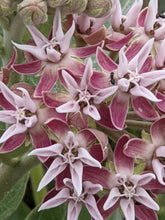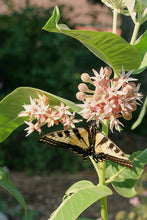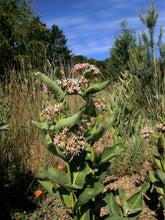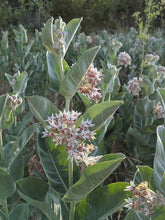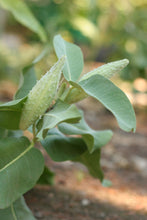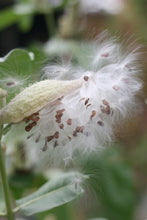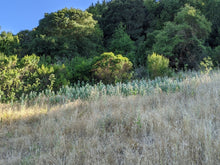
Asclepias speciosa
Showy milkweed is a robust perennial that is pure magic for pollinators - especially butterflies. Its pink, firework-shaped flowers are an incredible nectar source that attracts an array of bees and butterflies, its large blue-green leaves provide food for larval caterpillars, and the plant's alkaloid compounds boost butterflies' resistance to predators. In a region with relatively small populations of butterflies, due to our generally cloudy climate, Showy milkweed supports our local butterflies, while rewarding us gardeners with glimpses of their elegance.
- Plant type/canopy layer: deciduous, perennial, herbaceous plant
- Size at maturity: 36-48" tall, spreads laterally by rhizomes forming dense patches
- Light requirements: full sun to mostly sunny
- Moisture requirements: dry to moist soil, well-drained soil
- Bloom time: June - Aug
- Growth rate/ease: medium growth rate, easy to grow
- Wildlife support: flowers attract and provide nectar to hummingbirds, adult butterflies, bees and other insect pollinators; overall plant attracts and supports beneficial insects and other pest eating insects and is a caterpillar host plant and larval food source for native butterflies and moths
- Native habitat/range: common in valleys, roadsides, fields, near streams and disturbed areas, from sea level up to 1600m, in most areas of Oregon, as well as California, Idaho, Nevada, Washington, north to British Columbia, northeast to Manitoba, east to Michigan, southeast to Texas. Portland Plant List - no (though there are historical occurrences in Multnomah County so this could be disputed).
- Special features & uses: important plant for pollinators, specifically butterflies and hummingbirds
Gardening with Showy Milkweed: Showy milkweed prefers sunny to partially-sunny conditions with dry, well-drained soils - but it can tolerate moisture and even seasonal flooding if the water is fast-draining. It can also handle some drought once established. It is generally intolerant of root disturbance and can be slow growing at first. But, once established, it spreads aggressively by rhizomes and may form dense colonies, particularly in roadside ditches and other wild areas. Foliage dies back completely in winter, and emerges late the next spring in April or May, often one of the last to come up in a perennial flower bed.
Seed Packet Contains: approximately 50 seeds
Seed Sowing Instructions: Can be fall, spring, or summer sown, as it requires no stratification. Newly germinated seedlings are frost sensitive so mid-late spring to early summer sowing is suggested. Protect new seedlings if frost threatens. Mature plants come up late in the spring.
- Planting depth: 1/4” - just to cover
- Seeding rate: broadcast approx 20 seeds/sq ft, add 3-5 seeds per small pot or 3-5 seeds per spot (in situ)
Photo Credit 1 (flower w/insect): © Alison Northup, some rights reserved (CC-BY)
Photo Credit 2 (buds): © Brook, some rights reserved (CC-BY)
Photo Credit 3 (flower close-up): © joergmlpts, some rights reserved (CC-BY)
Photo Credit 4, 7, 8 (swallowtail, seed pod, seeds): Karli Del Biondo, Beetles and Bees
Photo Credit 5 (flowering habit): "Asclepias speciosa--RPBG--9 June 2007" by John Rusk is licensed under CC BY 2.0.
Photo Credits 6 & 9 (wild population from afar & close): © Ken-ichi Ueda, some rights reserved (CC-BY)











